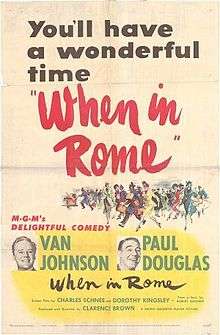When in Rome (1952 film)
| When in Rome | |
|---|---|
 | |
| Directed by | Clarence Brown |
| Produced by | Clarence Brown |
| Written by |
Robert Buckner Dorothy Kingsley Charles Schnee |
| Starring |
Van Johnson Paul Douglas Joseph Calleia |
| Music by | Carmen Dragon |
| Cinematography | William H. Daniels |
| Edited by | Robert Kern |
| Distributed by | Metro-Goldwyn-Mayer |
Release dates |
|
Running time | 78 minutes |
| Country | United States |
| Language | English |
| Budget | $1,313,000[1] |
| Box office | $683,000[1] |
When in Rome (1952) is a film starring Van Johnson, Paul Douglas, and Joseph Calleia. The film was released by Metro-Goldwyn-Mayer, and was based on a story by Robert Buckner, Dorothy Kingsley, and Charles Schnee. When in Rome was one of the last films directed by famed MGM director Clarence Brown .
Plot summary
Father John X. Halligan (Johnson) is a Catholic Priest visiting Rome, Italy for the 1950 Holy Year. Along the way, a con man named Joe Brewster (Douglas), who is wanted by American authorities, steals Halligan's clothing and his identity in the hopes of evading arrest.
The Italian police soon find the real Fr. Halligan, the police chief (Calleia) assures him that they will find and arrest Brewster. Halligan soon manages to track down Brewster on his own. The two men begin to develop a friendship of sorts and Brewster eventually makes his first confession in many years to Fr. Halligan. The two then make their way through the streets of Rome and the Vatican, visiting all the major basilicas as part of a pilgrimage. Halligan helps Brewster evade arrest long enough to complete his pilgrimage, while doing so they come across a monastery where the men never talk to anyone except to a superior. Brewster finds himself drawn to the place during his brief visit.
After visiting the monastery, Halligan and Brewster become separated. Halligan convinces the police to allow Brewster to complete his pilgrimage, at which point he is taken into custody. Halligan pleads with the police chief to release Brewster, and is convinced that Brewster is reformed. Then the news comes that Brewster had somehow escaped again, which leaves Halligan unsure of himself and his abilities.
Later retracing his steps, Halligan comes to the same monastery that he and Brewster had visited earlier. To his surprise he finds Brewster now living there as a monk. He asks the abbot if he believes that Brewster is sincere, the abbot thinks Brewster is, and that Brewster told him his whole story. Brewster, using a pen and paper to communicate, tells Halligan that while in prison he was in a place that was all past, and instead he wants to be in a place that is all future. He further asks Halligan when the next Holy Year will take place, Halligan responds that it would take place in 25 years. When Brewster asks if he'll visit then, Halligan assures him that he will.
Reception
According to MGM records the film made $503,000 in the US and Canada and $180,000 elsewhere, resulting in a loss of $918,000.[1]
